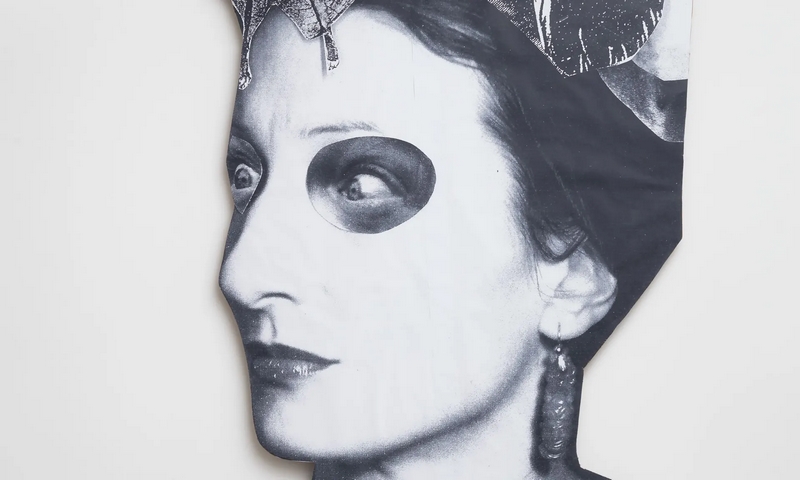
Detail from Monster Chetwynd’s Crazy Bat Lady, which will be included in the Tate Britain show. Photograph: Tate Britain/PA
Tate Britain is to temporarily rehang the last 60 years of its gallery displays with only female artists including Bridget Riley, Rachel Whiteread and Monster Chetwynd.
On Tuesday the gallery revealed that male artists will be jettisoned, from April and for a year at least, from the free galleries which tell the story of British art from 1960 until the present day.
Maria Balshaw, the director of Tate, said she hoped visitors would not notice because female artists should be a central part of recent art history. Galleries have made progress in better representing female artists “but it has been slow for too long. We are happy that it is speeding up”.
There will be about 30 artists represented by around 60 works from the Tate collection including paintings, sculpture, photography, drawing and film.
Tate said the rehang was part of a commitment to increase the representation of women across its galleries. Alex Farquharson, the director of Tate Britain, said: “The recent histories of the Turner prize, Tate’s exhibition programme and contemporary acquisitions reflect the critical role of women in the history of British art over the last 60 years.
“This presentation, 60 Years, will offer a significant moment to recognise and celebrate a selection of Britain’s most important artists working from the 1960s to the present day.”

Highlights of the display will include the first video installation to be acquired by Tate: Susan Hiller’s Belshazzar’s Feast, the Writing on Your Wall (1983-4).
It entered the collection in 1984 and is a multimedia installation that includes video, photography, sound, soft furnishings and artificial plants to recreate a living room late at night. Hiller was inspired by newspaper reports of apparitions seen on television screens in the days when broadcasting ended at around midnight.
There are flickering bonfire flames on the TV screen and a recording of Hiller’s young son trying to describe the National Gallery’s Rembrandt painting Belshazzar’s Feast from memory. The work was last shown at Tate Britain in 2003.

Other works will include Sarah Lucas’s 1997 sculpture Pauline Bunny, a mannequin figure made from stuffed pairs of tights; a painting, Zebe (2010), by the artist Tomma Abts, who won the Turner prize in 2006 for her intuitively made and precisely sized abstract paintings; and an example of the work of Lynette Yiadom-Boakye.
Yiadom-Boakye is best known for her paintings of black subjects, people largely absent from the European painting tradition. But she has repeatedly said it is not a political statement. “It just seemed normal to me,” she told the Observer. “It wasn’t my intention to put black faces back in the picture. It wasn’t political like that at all.”
The Yiadom-Boakye painting to be displayed will be The Generosity (2010), acquired in 2012.
More recently acquired pieces will include mixed media works by Chetwynd, the anarchic artist – previously known by first names Spartacus and Marvin Gaye – who has installed two enormous slug sculptures outside the gallery for Christmas.
Tate said the display was one of a number across its galleries in 2019 that would celebrate female artists. They include monographic shows devoted to Natalia Goncharova, Dora Maar and Dorothea Tanning at Tate Modern; Sol Calero at Tate Liverpool; Anna Boghiguian and Otobong Nkanga at Tate St Ives and Rose Finn-Kelcey and Joanna Piotrowska at Tate Britain.
It also precedes a wider rehang of Tate Britain planned for 2020.
All galleries would admit they have a lot of catching up to do when it comes to representing female artists in their collections and displays.
The National Portrait Gallery will, for example, next year stage the first major exhibition to tell the largely untold story of the women of pre-Raphaelite art. The show, Pre-Raphaelite Sisters, will shine light on artists such as Joanna Mary Wells, Marie Spartali Stillman, and Evelyn De Morgan, women left out of the history of a movement obsessed with its “male genius”.
On Wednesday, the National Gallery will unveil a newly acquired and cleaned painting by Artemisia Gentileschi, the most celebrated female artist of the Italian baroque.
guardian.co.uk © Guardian News & Media Limited 2010
Published via the Guardian News Feed plugin for WordPress.

